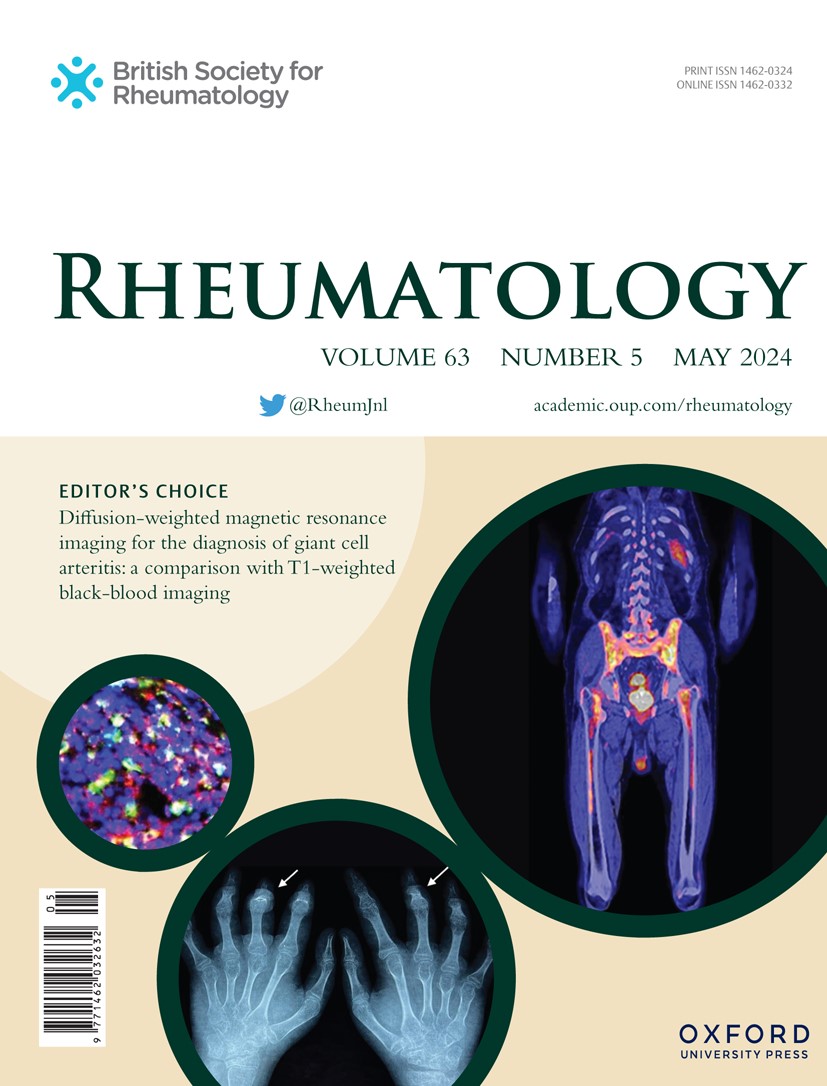Phenotypic clusters of patients with Takayasu arteritis predict disease activity at presentation, damage and future vascular complications
IF 4.4
2区 医学
Q1 RHEUMATOLOGY
引用次数: 0
Abstract
Objective To identify clusters of Takayasu arteritis (TAK) based on clinical features and their prognostic relevance. Methods Using agglomerative hierarchical clustering, clusters were defined on phenotype at presentation from 564 patients with TAK from three cohorts from India and Türkiye. Angiographic involvement, disease activity and Vasculitis Damage Index (VDI) at presentation, initiation of glucocorticoids or immunosuppressive agents, requirement for vascular procedures, and new-onset vascular complications were compared between clusters [unpaired Student’s t test or odds ratios (OR with 95%CI)]. Mortality rates [hazard ratios (HR) with 95%CI] were computed using Cox regression. Results Three clusters were identified (1 and 2, with sub-clusters 2A and 2B). Cluster 2 was younger and comprised relatively fewer women than cluster 1. Clinical features and angiography in cluster 1 reflected more frequent involvement of the arch of aorta and its branches as opposed to a greater involvement of the abdominal aorta and its branches in cluster 2. Cluster 2B more often had pan-aortic disease and left subclavian involvement than 2A. Fewer patients in cluster 2A were initiated on glucocorticoids [OR adjusted for center (aOR) 0.51 (0.31-0.83)] or immunosuppressants [aOR 0.35 (0.20-0.60)] or developed new-onset vascular complications [aOR 0.22 (0.07-0.74)] than cluster 1. Cluster 2B had higher VDI (3.98) than clusters 1(3.50) or 2A (2.46) and required more frequent vascular interventions than Cluster 1 or 2A (aOR 1.73-1.88, p < 0.05). Survival was similar across clusters [HR 2A vs 1 0.99 (0.43-2.29), 2B vs 1 1.20 (0.84-1.70)]. Conclusion Phenotypic clusters of TAK reflected distinct angiographic involvement with prognostic implications.高须动脉炎患者的表型群可预测疾病出现时的活动性、损伤和未来的血管并发症
目的探讨高须动脉炎(Takayasu arteritis, TAK)的临床特征及其与预后的相关性。方法采用聚类分层聚类方法,对来自印度和泰国三个队列的564例TAK患者的发病表型进行聚类。血管造影受累程度、疾病活动性和血管炎损伤指数(VDI)、开始使用糖皮质激素或免疫抑制剂、血管手术需求和新发血管并发症在组间进行比较[未配对学生t检验或比值比(or与95%CI)]。使用Cox回归计算死亡率[95%CI的危险比(HR)]。结果共鉴定出3个聚类(1和2,子聚类2A和2B)。第2组比第1组年轻,妇女人数相对较少。簇1的临床特征和血管造影反映主动脉弓及其分支受累较多,而簇2的腹主动脉及其分支受累较多。簇2B比2A更常有泛主动脉疾病和左锁骨下受累。与第1组相比,2A组患者开始使用糖皮质激素[中心校正比值(aOR) 0.51(0.31-0.83)]或免疫抑制剂[aOR 0.35(0.20-0.60)]或出现新发血管并发症[aOR 0.22(0.07-0.74)]的患者较少。群集2B的VDI(3.98)高于群集1(3.50)或群集2A(2.46),并且需要更频繁的血管干预(aOR为1.73-1.88,p < 0.05)。各组间生存率相似[HR 2A vs 0.99 (0.43-2.29), HR 2B vs 1.20(0.84-1.70)]。结论TAK的表型簇反映了明显的血管造影累及与预后的关系。
本文章由计算机程序翻译,如有差异,请以英文原文为准。
求助全文
约1分钟内获得全文
求助全文
来源期刊

Rheumatology
医学-风湿病学
CiteScore
9.40
自引率
7.30%
发文量
1091
审稿时长
2 months
期刊介绍:
Rheumatology strives to support research and discovery by publishing the highest quality original scientific papers with a focus on basic, clinical and translational research. The journal’s subject areas cover a wide range of paediatric and adult rheumatological conditions from an international perspective. It is an official journal of the British Society for Rheumatology, published by Oxford University Press.
Rheumatology publishes original articles, reviews, editorials, guidelines, concise reports, meta-analyses, original case reports, clinical vignettes, letters and matters arising from published material. The journal takes pride in serving the global rheumatology community, with a focus on high societal impact in the form of podcasts, videos and extended social media presence, and utilizing metrics such as Altmetric. Keep up to date by following the journal on Twitter @RheumJnl.
 求助内容:
求助内容: 应助结果提醒方式:
应助结果提醒方式:


